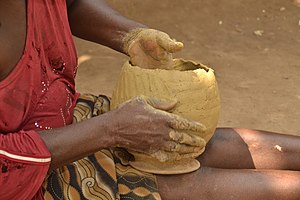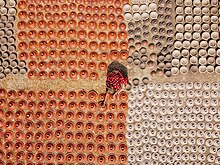 Global Information
Global InformationPottery information


Pottery is the process and the products of forming vessels and other objects with clay and other raw materials, which are fired at high temperatures to give them a hard and durable form. The place where such wares are made by a potter is also called a pottery (plural potteries). The definition of pottery, used by the ASTM International, is "all fired ceramic wares that contain clay when formed, except technical, structural, and refractory products".[1] End applications include tableware, decorative ware, sanitary ware, and in technology and industry such as electrical insulators and laboratory ware. In art history and archaeology, especially of ancient and prehistoric periods, pottery often means vessels only, and sculpted figurines of the same material are called terracottas.

Pottery is one of the oldest human inventions, originating before the Neolithic period, with ceramic objects such as the Gravettian culture Venus of Dolní Věstonice figurine discovered in the Czech Republic dating back to 29,000–25,000 BC.[2] However, the earliest known pottery vessels were discovered in Jiangxi, China, which date back to 18,000 BC. Other early Neolithic and pre-Neolithic pottery artifacts have been found, in Jōmon Japan (10,500 BC),[3] the Russian Far East (14,000 BC),[4] Sub-Saharan Africa (9,400 BC),[5] South America (9,000s–7,000s BC),[6] and the Middle East (7,000s–6,000s BC).

Pottery is made by forming a clay body into objects of a desired shape and heating them to high temperatures (600–1600 °C) in a bonfire, pit or kiln, which induces reactions that lead to permanent changes including increasing the strength and rigidity of the object. Much pottery is purely utilitarian, but some can also be regarded as ceramic art. An article can be decorated before or after firing.
Pottery is traditionally divided into three types: earthenware, stoneware and porcelain. All three may be glazed and unglazed. All may also be decorated by various techniques. In many examples the group a piece belongs to is immediately visually apparent, but this is not always the case; for example fritware uses no or little clay, so falls outside these groups. Historic pottery of all these types is often grouped as either "fine" wares, relatively expensive and well-made, and following the aesthetic taste of the culture concerned, or alternatively "coarse", "popular", "folk" or "village" wares, mostly undecorated, or simply so, and often less well-made.
Cooking in pottery became less popular once metal pots became available,[7] but is still used for dishes that benefit from the qualities of pottery cooking, typically slow cooking in an oven, such as biryani, cassoulet, daube, tagine, jollof rice, kedjenou, cazuela and types of baked beans.[7]
- ^ 'Standard Terminology Of Ceramic Whitewares And Related Products.' ASTM C 242–01 (2007.) ASTM International.
- ^ Cite error: The named reference
Venuswas invoked but never defined (see the help page). - ^ Diamond, Jared (June 1998). "Japanese Roots". Discover. Discover Media LLC. Archived from the original on 2010-03-11. Retrieved 2010-07-10.
- ^ Cite error: The named reference
fareastrussiawas invoked but never defined (see the help page). - ^ Simon Bradley, A Swiss-led team of archaeologists has discovered pieces of the oldest African pottery in central Mali, dating back to at least 9,400BC Archived 2012-03-06 at the Wayback Machine, SWI swissinfo.ch – the international service of the Swiss Broadcasting Corporation (SBC), 18 January 2007
- ^ Roosevelt, Anna C. (1996). "The Maritime, Highland, Forest Dynamic and the Origins of Complex Culture". In Frank Salomon; Stuart B. Schwartz (eds.). The Cambridge History of the Native Peoples of the Americas. Cambridge, England New York: Cambridge University Press. pp. 264–349. ISBN 978-0-521-63075-7. Archived from the original on 2019-12-07. Retrieved 2019-10-17.
- ^ a b Heck, Mary-Frances. "The Food & Wine Guide to Clay Pot Cooking". Food & Wine. Retrieved 2022-01-26.